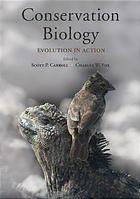
Conservation biology : evolution in action PDF
Preview Conservation biology : evolution in action
conservation biology This page intentionally left blank CONSERVATION BIOLOGY Evolution in Action Edited by Scott P. Carroll Charles W. Fox 1 2008 3 OxfordUniversityPress,Inc.,publishesworksthatfurtherOxfordUniversity’s objectiveofexcellenceinresearch,scholarship,andeducation. Oxford NewYork Auckland CapeTown DaresSalaam HongKong Karachi KualaLumpur Madrid Melbourne MexicoCity Nairobi NewDelhi Shanghai Taipei Toronto Withofficesin Argentina Austria Brazil Chile CzechRepublic France Greece Guatemala Hungary Italy Japan Poland Portugal Singapore SouthKorea Switzerland Thailand Turkey Ukraine Vietnam Copyright©2008byOxfordUniversityPress,Inc. PublishedbyOxfordUniversityPress,Inc. 198MadisonAvenue,NewYork,NewYork10016 www.oup.com OxfordisaregisteredtrademarkofOxfordUniversityPress Allrightsreserved.Nopartofthispublicationmaybereproduced, storedinaretrievalsystem,ortransmitted,inanyformorbyanymeans, electronic,mechanical,photocopying,recording,orotherwise, withoutthepriorpermis sionofOxfordUniversityPress. LibraryofCongressCataloging-in-PublicationData Conservationbiology:evolutioninaction/editedbyScottP.Carroll andCharlesW.Fox. p.cm. Includesbibliographicalreferencesandindex. ISBN:978-0-19-530679-8;978-0-19-530678-1(pbk.) 1.Conservationbiology.I.Carroll,ScottP.II.Fox,CharlesW. QH75.C66152008 576—dc22 2007044664 9 8 7 6 5 4 3 2 1 PrintedintheUnitedStatesofAmerica onacid-freepaper Preface At no time in the nearly four billion years since provides the foundation for designing new and the origin of life on earth has our planet seen integrative strategies. Central to our perspective is such tremendous environmental change. Even the the discovery that a great many organisms, from major mass extinctions in prehuman earth his- microbestotrees,arerapidlyevolvinginresponseto tory (Raup & Sepkoski, 1982) are mere blips theirchangingenvironments.Asrisksandresources in comparison with the current biodiversity crisis. changeinform, distribution, andabundance, they Human actions and impacts such as the elimina- create new niches, affect competition, add or sub- tion, fragmentation, and conversion of habitats; tractenemies,andgenerallyrecastthelandscapefor mass poisoning; overharvesting; species introduc- surviving taxa. Selection is now operating in new tions; and climate change dramatically alter the directions and at new intensities, and the degree localandglobalcarryingcapacitiesofotherspecies. towhichpopulationsrespondadaptivelycandeter- But they also do more. By modifying the chal- mine their capacity to persist. Moreover, adaptive lengesorganismsface,andtheresour cestheyhave evolution, emerging from the demographic and toaddressthosechallenges,wearealteringthecon- geneticchaossufferedby“refugeetaxa,”mayprove ditions under which behavioral and physiological to be of foremost importance in altering the form traitsareexpressedandinwhichecologicalinterac- and structure of species, interspecific interactions, tionsoccur.Thesechangesaffecttheselectiveenvi- andcommunitiesinthecomingyears,decades,and ronments encountered by organisms, influencing millennia. evolutionarydynamics,whichinturnfeedbackto If heretofore unanticipated, widespread evolu- affectecologicaldynamics.Conservationproblems tion is itself a major component of global change. arethuseco-evolutionaryinnature,ratherthanjust Staticmodels—thosethattreattheecologicalplay- ecological, demographic, or genetic (Kinnison & ers as passive bystanders in the ecological play— Hairston, 2007). This ecoevolutionary nature of are now obsolete. Understanding and managing responses to environmental change is the focus of ongoing adaptation to global change requires new thisbook. perspectives to accommodate, exploit, and man- Thereisthusaclearandpresentneedtodevelop age evolutionary processes of conservation con- practical approaches to managing our biodiver- cern,whichincludepopulationstructuringandthe sity problems that consider a role of evolution pace and extent of gene flow, the maintenance occurring during the time frame of the conser- and expression of phenotypic polymorphisms and vation program. Evolutionary theory is the pre- plasticity, niche specialization versus generalism, dictive core of the biological sciences, and it costs versus benefits of harvesting and of genetic vi Preface engineering, and diversity management decisions Allchaptersinthisbookwerereviewedbypeers, above and below the species level. If we succeed usually two or three scientists with expertise in in protecting species and biota demographically, thetopicscoveredbythechapter. Thesereviewers a chief outcome may be to provide raw mate- offeredinsightfulcommentaryonthechaptersand rial for both targeted and unmanaged evolution. have made this a much better volume. We thank Accordingly, the principal challenge of evolution- Karina Acevedo-Whitehouse, Paul Agapow, Fred ary conservation biology is to predict and then Allendorf, Suzanne Alonzo, Mike Angilletta, Tris- manage evolutionary dynamics, and make con- tanArmstrong, LeslieBlancas, JanetteBoughman, servation (and preservation) plans that maximize Juan Bouzat, Linda Broadhurst, Jeremy Burdon, evolutionarypotential—forexample,byprotecting Mar Cabeza, Christina Caruso, Denis Couvet, communitiesthathaveunprecedentedassemblages Richard Cowling, George Gilchrist, John Kelly, ofjuxtaposed,andrapidlyevolving,remnanttaxa. HollyKindsvater,MikeKinnison,MikeLoeb,Arne Itisourhopethattheauthorsofthisvolumeprovide Mooers, Patrick Nosil, Stephen O’Brien, Julian insightsthatultimatelycontributetothesuccessof Olden, Otso Ovaskainen, William Perry, David suchefforts. Reed, Gerald Rehfeldt, Kevin Rice, Kim Scrib- This volume is intended to introduce, explore, ner, Mike Singer, David Tallmon, John Thomp- andelaborateevolutionaryapproachestoconserva- son,PeterThrall,AndrewWeeks,AlastairWilson, tionbiology.Thevolumeisdividedintofiveparts, and a few reviewers who asked to remain anony- each of which is preceded by a brief introduction mous,fortheirconstructivecommentsonindividual andcommentary. ThechaptersinPartI,“Popula- chapters.WeespeciallythankMikeLoebforcopy- tion Structure and Genetics of Threatened Taxa,” editingchaptersandcompilingthefinalversionof present the history and general concepts of con- thebook. servation genetics, and examine the interaction of Last,andmostimportant,wethanktheauthors genetic and demographic factors. Part II, “Con- for their dedication to this project. The success of serving Biodiversity within and among Species,” this volume, and its influence on the conservation focusesonevolutionaryprocesses,theirrelationship community, ultimately depends on the quality of to biodiversity at different taxonomic levels, and thechaptersandthusonthehardwork,creativity, how they influence practical conservation issues, andinsightofthecontributingauthors. Thanksto includingthereintroductionofthreatenedtaxaand allofyou! thelossofdistinctivepopulationstohybridization. The chapters in Part III, “Evolutionary Responses ScottP.Carroll to Environmental Change,” examine both genetic CharlesW.Fox andphenotypicmodesofadaptationtothestresses and opportunities associated with g lobal change phenomena. Part IV, “Conservation of the Co- REFERENCES evolving Web of Life,” examines the evolutionary and co-evolutionary causes and consequences of changing interspecific dynamics, including species Kinnison,M.T.,&N.G.HairstonJr.2007. invasions,extinctions,andhostparasitedynamics. Eco-evolutionaryconservationbiology: The fifth and concluding portion of the volume, Contemporaryevolutionandthedynamicsof “Evolutionary Management,” presents evolution- persistence.FunctEcol.21:444–454. Raup,D.,&J.Sepkoski.1982.Massextinctions ary analyses of three critically important areas: inthemarinefossilrecord.Science reservedesign,managementoftransgeneflowinto 215:1501–1503. the wilds, and the sustainable harvest of wild populations. Contents ListofContributors x PartI PopulationStructureandGeneticsofThreatenedTaxa Introduction 1 CharlesW.Fox,ScottP.Carroll 1 TheHistory,Purview,andFutureofConservationGenetics 5 JohnC.Avise 2 EffectsofPopulationSizeonPopulationViability:FromMutationto EnvironmentalCatastrophes 16 DavidH.Reed 3 DemographicsversusGeneticsinConservationBiology 35 BarryW.Brook 4 MetapopulationStructureandtheConservationConsequences ofPopulationFragmentation 50 JuliannoB.M.Sambatti,EliStahl,SusanHarrison 5 TheInfluenceofBreedingSystemsandMatingSystemsonConservation GeneticsandConservationDecisions 68 MicheleR.Dudash,CourtneyJ.Murren PartII ConservingBiodiversitywithinandamongSpecies Introduction 81 FredW.Allendorf 6 TheImportanceofConservingEvolutionaryProcesses 85 ThomasB.Smith,GregoryF.Grether 7 PhylogeneticDiversityandConservation 99 DanielP.Faith viii Contents 8 GeneticConsiderationsofIntroductionEfforts 116 PhilippineVergeer,N.JoopOuborg,AndrewP.Hendry 9 Hybridization,Introgression,andtheEvolutionaryManagement ofThreatenedSpecies 130 JudithM.Rhymer PartIII EvolutionaryResponsestoEnvironmentalChange Introduction 141 GeorgeW.Gilchrist,DonnaG.Folk 10 EvolutioninResponsetoClimateChange 145 JulieR.Etterson 11 EvolutionaryDynamicsofAdaptationtoEnvironmentalStress 164 GeorgeW.Gilchrist,DonnaG.Folk 12 ManagingPhenotypicVariabilitywithGeneticand EnvironmentalHeterogeneity:AdaptationasaFirstPrinciple ofConservationPractice 181 ScottP.Carroll,JasonV.Watters 13 GeneticDiversity,AdaptivePotential,andPopulation ViabilityinChangingEnvironments 199 ElizabethGraceBoulding PartIV ConservationoftheCoevolvingWebofLife Introduction 221 JohnN.Thompson 14 TheGeographicMosaicofCoevolutionandItsConservation Significance 225 CraigW.Benkman,ThomasL.Parchman,AdamM.Siepielski 15 TheNextCommunities:EvolutionandIntegrationof InvasiveSpecies 239 ScottP.Carroll,CharlesW.Fox 16 EcosystemRecovery:LessonsfromthePast 252 GeeratJ.Vermeij 17 Host–PathogenEvolution,Biodiversity,andDisease RisksforNaturalPopulations 259 SoniaAltizer,AmyB.Pedersen PartV EvolutionaryManagement Introduction 279 MichaelT.Kinnison Contents ix 18 ConservationPlanningandGeneticDiversity 281 MaileC.Neel 19 ImplicationsofTransgeneEscapeforConservation 297 MichelleMarvier 20 EvolutionandSustainabilityofHarvestedPopulations 308 MikkoHeino,UlfDieckmann References 325 Index 377
